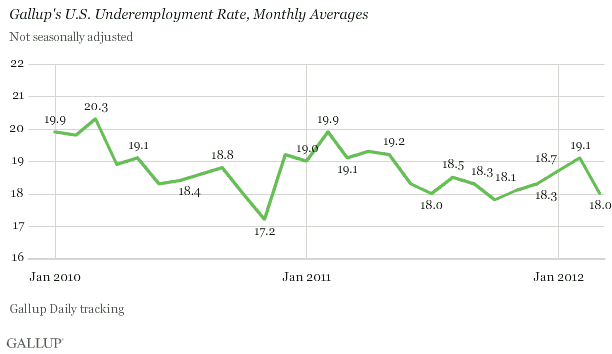Gallup Poll Watch: U.S. Unemployment Rate Falls in March But…

U.S. unemployment, as measured by Gallup without seasonal adjustment, declined to 8.4% in March from 9.1% in February, while Gallup’s seasonally adjusted rate fell to 8.1% from 8.6% in February.
These results are based on Gallup Daily tracking interviewing conducted in March, including interviews with 31,283 U.S. adults, 67.8% of whom are active in the workforce. Gallup’s seasonally adjusted unemployment rate is based on the adjustment used by the Bureau of Labor Statistics in the same month of the previous year.
On an unadjusted basis, the March unemployment rate matches the previous low since Gallup began monitoring and reporting unemployment in January 2010. The unadjusted unemployment rate was last at 8.4% in October and November 2011. On a seasonally adjusted basis, March’s 8.1% reading is near the monthly low of 7.9% for Gallup’s U.S. unemployment rate, seen in January of this year. In both cases, Gallup trends show the U.S. unemployment rate declining dramatically over the past year.
This is some good news for the American economy. And, why President Obama has been rising in the polls, as of late.
Americans are feeling better about their jobs and their economic job prospects.
Underemployment has dramtically fallen.
Gallup’s U.S. underemployment measure combines those unemployed with those working part time but looking for full-time work. As a result of sharp declines in both of these groups, the underemployment rate, on an unadjusted basis, fell to 18.0% in March from 19.1% in February 2012. The underemployment rate declined to as low as 18.0% last July before reversing course in August; it also increased from November through January.
Here is the chart:

Now, these numbers are from Gallup and not the government, Bureau of Labor Services. Here is the comparison chart:

Whichever the numbers, there is a decided downward trend = good news for Americans.
So, what does this all mean?
Gallup’s seasonally adjusted unemployment rate decreased in March to 8.1%, slightly higher than January’s 7.9% reading but an improvement from 8.5% in Gallup’s preliminary mid-March estimate. The March and January rates are the two lowest since Gallup began monitoring and reporting unemployment in January 2010. They are also consistent with Gallup’s other behavioral economic data for March showing a new high in Gallup’s Economic Confidence Index and a post-recession high in its Job Creation Index as well as strong consumer spending.
While the sharp drop in the U.S. unemployment rate during recent months is clearly good news, it raises some significant economic questions. Traditional economic analysis raises the question of why the unemployment rate is falling much more rapidly than can be justified by the modest pace of current economic growth. Answering this question is essential to determining the sustainability of the declining trend in unemployment.
Federal Reserve Board Chairman Ben Bernanke made this issue the centerpiece of his recent speech to the National Association for Business Economics, noting, “the better jobs numbers seem somewhat out of sync with the overall pace of economic expansion.” He went on to explain his hypothesis that companies shed many more jobs than necessary during the recession and financial crisis of 2008-2009, and now they are correcting their workforces for this understaffing of the past. The chairman went on to suggest that achieving further declines in the unemployment rate is likely to require a more rapid pace of economic growth going forward.
f Bernanke is right, then the rapid decline in the unemployment rate might be approaching its end as individual businesses achieve a right-sizing of their workforces. Further, traditional economics also suggest that many people who have been sitting on the sidelines waiting for the economy to improve might decide that now is the time to seek a job, increasing the baseline figure used to calculate unemployment. In turn, this could keep the unemployment rate from decreasing or even send it higher, negatively affecting economic confidence and the overall economy — not good news for political incumbents, including the president.
On the other hand, the economy might continue to build on the momentum indicated by the current positive trend in Gallup’s behavioral economic data, or perhaps the economy is already growing faster than the current economic data suggest. Either way, if true, the unemployment rate could fall below 8.0% in the not-too-distant future — particularly if the workforce does not grow — meaning good things for the economy, incumbents, and the president’s re-election effort.
In other words, this decline in unemployment and underemployment may be an outlier from economic activity or a portent for increasing economic growth to come.
Again, stay tuned…
2 Comments
Willis Forster
Figures do not lie, but liars can figure. These numbers are politically adjusted in both cases.
Gregory Flap Cole
Gallup is a pretty reputable and accurate private polling firm. Now, the BLS figures that will come out tomorrow are subject to more political influence.